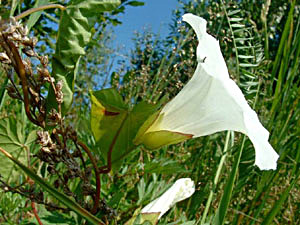
medicinal herbs
Hedge Bindweed
Calystegia sepium

Herb: Hedge Bindweed
Latin name: Calystegia sepium
Synonyms: Convolvulus sepium
Family: Convolvulaceae (Morning-glory Family)
Medicinal use of Hedge Bindweed:
The root is demulcent, diuretic, febrifuge, poultice and strongly purgative. Use of the root is believed to increase the flow of bile.Description of the plant:

Plant:
Perennial Climber
Height:
3 m(9 3/4 foot)

Flowering:
July toSeptember
Habitat of the herb:
Hedges, fences, edges of woods, waste ground etc.Edible parts of Hedge Bindweed:
Stalks and root - cooked. Washed and steamed. A pleasant sweet taste. Rich in starch and sugars, it is very nutritious. It should not be eaten regularly, however, due to its possible purgative effect. Young shoots - cooked. Some caution is advised since they are possibly purgative.Other uses of the herb:
The stems are very flexible and can be used as an emergency string for tying. It is fairly strong but not very long-lasting.Propagation of Hedge Bindweed:
Seed - sow spring in a cold frame in a free draining compost and only just cover. The seed usually germinates in 1 - 3 months at 15°C. When they are large enough to handle, prick the seedlings out into individual pots and grow them on in a cold frame for at least their first winter. Plant them out into their permanent positions in late spring or early summer, after the last expected frosts. Division in early spring whilst dormant.Cultivation of the herb:
Hedges, fences, edges of woods, waste ground etc.Known hazards of Calystegia sepium:
This species is said to be purgative, some caution is advised.Plant information taken from the Plants For A Future.
